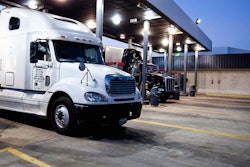As regular readers will know, I spent time early this week out at the Truckload 2021 annual conference of the Truckload Carriers Association, where Tuesday night was unveiled the ultimate winner of the Owner-Operator of the Year program we partner with TCA on. Here's a big congrats to five-time finalist Bryan Smith for the big win -- and both Glen Horack and Doug Schildgen, runners-up, for their success. (Horack, leased to Prime, is now a three-time finalist himself.)
I'll echo owner-operator Smith's commentary from the TCA stage Tuesday night and encourage independents to enter the next contest, and small fleet owners to nominate their best drivers. The contest is open to independents and leased owner-operators – with up to five trucks, where the owner still drives. Follow the link here to access this next year's contest, or nominate another owner or driver through October 25.
[Related: Fifth time's a charm for Bryan Smith, who bags the big prize from TCA/Overdrive]
Truckload 2021 yielded plenty other discussion, too, some of it germane to a data analysis Avery Vise recently conducted in his role at FTR Transportation Intelligence and that FTR was kind of enough to share with me last week. That analysis looks at truck counts and how they've changed over the course of the pandemic period, taking a snapshot of carrier census data (as self-reported by carriers on their MCS-150 forms) as of March of 2020 and comparing that to another snapshot taken in September 2021.

What it shows is illuminating -- if incomplete, as data-quality issues with self-reported carrier data are well-known -- and laid out in part in the charts below here. Vise's analysis seems to confirm a lot of what's been bandied about in anecdote after anecdote. Todd Amen, president of owner-operator business services provider ATBS, noted two weeks back that he knew of just two sizable partner fleets who'd grown in the past 12 months.
Knight Transportation chairman Kevin Knight, speaking during an executive panel at Truckload 2021 also Tuesday, put it succinctly: "we’re not a growth industry anymore" in the present moment. Knight's Q2 earnings report shows tractor count down 2 percent to 18,034 this year, compared to the same quarter last year. Kevin Knight was speaking in the context of driver pay when he went on to note that, for large fleets, there are "more ways to put your capital to work rather than just going out and buying another truck." It's worth noting that Knight views what's happening with increasing rates and driver pay as a fundamental correction to a large degree and is hopeful it sticks into the future.
He sees the rates/driver pay rise continuing, yet is skeptical of a large amount of fleet-size growth.
The lag in new truck builds is well-known all around trucking, as Prime, Inc., leader Robert Low elaborated on Knight's point. Yet for small fleets, rate growth has in fact spurred truck-count expansion in the smaller-fleet realm to much greater degrees over the pandemic period than for large companies, as shown below via Vise's analysis.
The first graph's bars represent the number of trucks added in aggregate over the course of the pandemic in each carrier-size category (labeled along the bottom). The second shows that same number of trucks added as a percentage of the total in each carrier-size category (labeled along the left).
Low cautioned the numerous newly independent owner-operators as well as smaller fleets not to base too much of their business models on peak conditions we're currently seeing, given a turn down that will eventually come. "Who’s buying trucks now?" he asked. "You can’t get new trucks. Independent contractors and drivers get on load boards and see these fantastic rates, then base their business plans on those unsustainable rates."
Those buying used trucks, today at prices well higher than a normal time, Low contended, are "buying our [larger fleets'] trucks. ... There's no capacity coming from established larger fleets -- the older equipment is getting sold and it's shifting to those [smaller] carriers."
He felt "there will be some equilibrium reached next year or the year after," he said, in the supply/demand equation in the freight market. "Then what happens to the little guy?" Will that little guy be able to "get to that point where their capital structure is such that they can finance that newer truck?"
[Related: Will the spot market rates 'correction' remain corrected?]
That will be key to any long-term maintenance of the growth dynamics shown in the charts above.
As noted, Low views it all as more of a shift than true capacity growth. Key to building that capital structure may well be establishing the war chest and the track record of success.
Yet as Low also noted, for any fleet investing in equipment now, it's of no use to the business if "they can’t find a driver," he said. "You have to have a seated truck. That’s what counts."
Clearly, many small fleets are winning the day in competition for those drivers, if the numbers in the chart are any indication of true, seated capacity, though many of the independents represented in the 1-truck category are likely to be running power-only for a larger entity like Prime or Knight's brokerage.
From a purely competitive standpoint, might small fleets stand to benefit further in that regard from Biden's vaccine/weekly-test mandate for larger employers? If we can read anything into the anti-mandate views of large-carrier interests like the American Trucking Associations and TCA itself, it's that they worry about a mandate's effects on their already hampered ability to recruit and hold on to driver employees -- and possible even lose more to smaller operations. (For the record, OOIDA too has come out against vaccine mandates but for reasons of personal/business choice, solely.)
ATA was explicit in that regard, when ATA leader Chris Spear charged the Biden plan with being discriminatory in nature. "Why the discriminatory 100-employee threshold, picking winners and losers for both employees and employers?" Spear asked.
TCA didn't call out the small v. big issue, but promoted a different angle in its vax/test-mandate opposition, with current chairman Jim Ward issuing a call for members to contact their reps. The mandate, he believed, could "lead to a massive driver exodus from this great industry. Already faced with a shrinking pool of drivers from COVID-19 itself, we are all confronted with the pervasive challenge of locating qualified drivers to deliver our nation’s freight safely, effectively, and efficiently."
Though truck numbers don't equal employee numbers at any given company, here's the aggregate number-of-trucks growth numbers of the March 2020-September 2021 period above and below the 100-truck carrier dividing line, illustrating where growth has happened over the course of the pandemic.
The recruiting and retention challenge isn't limited to larger fleets, of course -- I talked just last week with a small fleet owner who'd entered our Small Fleet Champ competition and who has a couple of power units idled essentially for the same reason, lack of a driver, leaving that fleet operating at just around 75% of potential capacity.
In response to a question from the audience on Tuesday -- How many drivers will leave if the vax mandate happens? -- neither Low nor Knight put a number of it.
Knight brought up the need to "be as transparent as we can with our driver force," he said. The company had "let them know we’re not planning on doing anything until we know what we’re supposed to do." He challenged employers not to overreact. "Learn and listen ... We’re going to work through this."
Low noted Prime's largely independent contractor owner-operator fleet like as not wouldn't come under the mandate, though its company driver fleet certainly would.
[Related: Vaccine skepticism -- reasons for it are as varied as the trucking community]
Yet Vise speculated an eventual Occupational Safety and Health Administration-written vaccine rule might well include independent contractors, depending on "how is the rule drafted," he said. Given Biden's long support from union interests, "they may try to draft the rule to include independent contractors," for reasons that "they don’t want to give an incentive to folks to turn employees into independent contractors."
While personally, Vise said he thought the vax/test-mandate move was likely purely political and may never take effect, "we're in a big versus small issue," he added, when it comes to potential impacts on trucking companies and any competitive edge for smaller or large fleets that results. Vise said he felt smaller carriers, if exempted from any mandate below the 100-employee mark, would be more likely to feel positive impacts in bids for fleet expansion.
ATA may well have a point when it charges the Biden plan with being discriminatory, casting doubt on its eventual creation in the form of an OSHA-written and -implemented rule. A longtime former OSHA administrator told Time magazine just a couple days ago that, “when it comes to protecting workers from serious hazards, OSHA doesn’t distinguish between workplaces of different sizes.”
Time will tell on whether any of that comes to pass. For now, though the day-to-day difficulties of running a small trucking business are real, and they're not going anywhere, from a bird's-eye view I'd say independents and small fleets have been in the catbird seat when it comes to growth in recent history. It'll take continued cost and revenue diligence, creativity, and a little bit of luck when it comes to economic conditions, to remain there.










